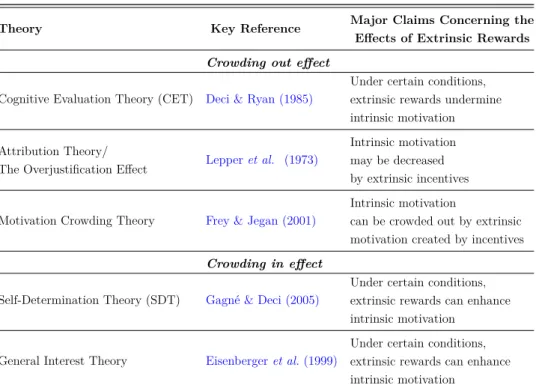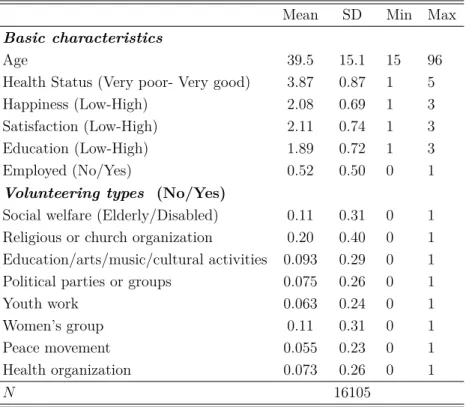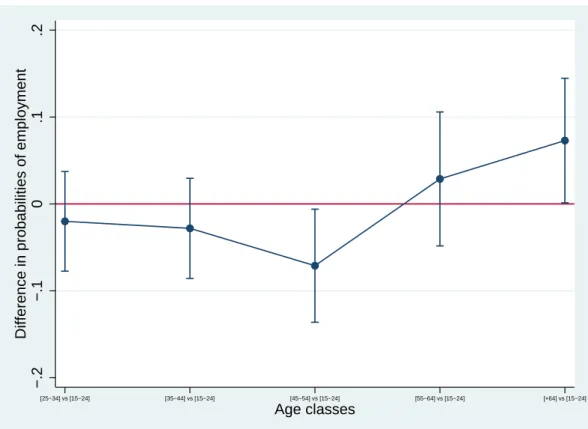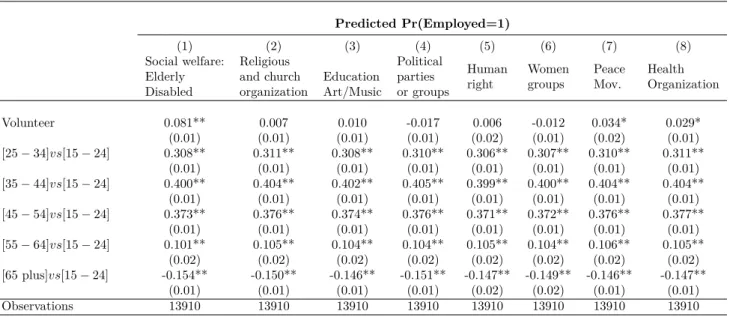RESEARCH OUTPUTS / RÉSULTATS DE RECHERCHE
Author(s) - Auteur(s) :
Publication date - Date de publication :
Permanent link - Permalien :
Rights / License - Licence de droit d’auteur :
Institutional Repository - Research Portal
Dépôt Institutionnel - Portail de la Recherche
researchportal.unamur.be
University of Namur
Volunteering at the extensive margin
Daye, Modeste
Published in:
Annals of Economics and Statistics
DOI:
10.15609/annaeconstat2009.131.0117
Publication date:
2018
Document Version
Peer reviewed version
Link to publication
Citation for pulished version (HARVARD):
Daye, M 2018, 'Volunteering at the extensive margin: intrinsic or extrinsic motive?', Annals of Economics and
Statistics, vol. 131, no. 131, pp. 117-136. https://doi.org/10.15609/annaeconstat2009.131.0117
General rights
Copyright and moral rights for the publications made accessible in the public portal are retained by the authors and/or other copyright owners
and it is a condition of accessing publications that users recognise and abide by the legal requirements associated with these rights.
• Users may download and print one copy of any publication from the public portal for the purpose of private study or research.
• You may not further distribute the material or use it for any profit-making activity or commercial gain
• You may freely distribute the URL identifying the publication in the public portal ?
Take down policy
If you believe that this document breaches copyright please contact us providing details, and we will remove access to the work immediately
and investigate your claim.
Volunteering at the extensive margin: intrinsic or
extrinsic motive?
∗
Modeste Dayé
†
Abstract
This paper identifies the nature of the predominant motive (consumption versus investment)
moving people to offer labour for free by considering the major beneficiary sectors involved.
Using basic consumption and investment models, some hypotheses are derived and tested
to identify the salient motivation for volunteering in each sector.
The analysis results
in two main findings: (a) in peace movements and in women’s groups and associations,
volunteers seem to be mainly intrinsically motivated and (b) in sectors concerned with social
welfare for the elderly people or in religious and health organizations, the key motivation
for volunteering is investment (extrinsic returns).
Keywords: volunteering, intrinsic motive, labour supply.
JEL codes: C13, D11, J22, C26.
Résumé
L’objectif de ce papier est d’identifier la principale motivation (consommation ou
investise-ment) du bénévolat en considérant les principaux secteurs bénéficaires. A cet effet, l’étude
se fonde sur des modèles de consommation et d’investissement desquels sont dérivées
dif-férentes hypothèses qui sont testées. Deux principaux résultats découlent du papier: (a)
le bénévolat dans les mouvements et associations pour le maintien de la paix et dans les
groupements et associations de femmes semble principalement mu par des motifs de
con-sommation (bien-être procuré par la cause défendue) alors que (b) dans les associations
s’occupant du bien-être des personnes âgées, les organisations relevant du secteur de la
santé, et dans les organisations religieuses, les volontaires semblent être beaucoup plus
motivés par les retours sur l’investissement de leur temps.
Mots clés: volontariat, motivations intrinsèques, offre de travail.
Codes JEL : C13, D11, J22, C26.
∗
I am grateful to Pierre Picard and two anonymous referees. I thank Paul Seabright, Paul Reding,
Romain Houssa, Vincenzo Verardi and Jean-Marie Baland for insightful discussions. I also thank Jean
Debauche, Albena Sotirova and Françoise Delmez for helpful comments, and the audience of the CRED
Workshop in Namur.
†
Center of Research in the Economics of Development (CRED), Department of Economics, University
of Namur, E-mail: modeste.daye@unamur.be.
1
Introduction
People face two main types of incentive while entering volunteering: some
are categorized as intrinsic motivation and others as extrinsic motivation.
An individual is intrinsically motivated to volunteer if it is internally
re-warding for her to do so. In that vein, volunteering is undertaken for the
sheer joy arising from performing the underlying activities ("warm-glow"
utility,
Andreoni (1989)
) or for some purely altruistic purposes. Conversely,
if volunteering is mainly driven by some external expected rewards, the
mo-tivation to volunteer is referred to as extrinsic.
The aim of this paper is to analyze the nature of the main incentives
moving people to volunteer by considering different beneficiary sectors.
More specifically, the paper attempts to find out in which major
volun-teering sectors (political parties, religious organizations, social welfare for
the elderly, women’s groups or associations, etc.), motivation is likely to
be mainly intrinsically driven, and which sectors seem rather to attract on
average, volunteers willing to invest in human and social capital (people
motivated by the underlying returns).
Analyzing volunteering and the underlying motivations has a double
interest. First, volunteering does not seem to be a market oriented
be-haviour in the sense that it is not directly priced, although the economic
theory would suggest a return in terms of wage for a labour supply, given
a corresponding demand. Second, the literature (Table
1
) shows that
un-der certain conditions, intrinsic and extrinsic motivations might be at odds
(
Lepper, Greene & Nisbett (1973)
;
Deci & Ryan (1985)
;
Frey & Jegan
(2001)
) or complementary (
Eisenberger, Pierce & Cameron (1999)
;
Gagné
& Deci (2005)
). Therefore, the nature of the interaction between the two
types of motivation is important for any policy targeting better
perfor-mance by using external rewards as incentive devices, in particular in
sec-tors where the key motivation making people volunteer is intrinsic. The
cognitive evaluation theory for example (
Deci & Ryan (1985)
, Table
1
)
which builds on people’s psychological needs for autonomy and competence
suggests that what matters for intrinsic motivation is the ability to express
own competence and self-control over the outcomes of the performed tasks.
Consequently any external incentive decreasing either the feeling of
com-petence or self-control
1crowds out intrinsic motivation and self-interest in
the activity (
Ledford, Gerhart & Fang (2013)
). The Attribution or
Over-justification theory (
Lepper et al. (1973)
) applies in a similar way: when
people are mainly intrinsically motivated for some tasks, external rewards
might induce them to start focusing on the rewards per se at the expense
of their intrinsic motivation or self interest in the activities. Based on these
predictions, whenever intrinsic motivation is predominant in a sector which
benefits from volunteering, a policy, targeting for instance better
perfor-mance or self-interest improvement by providing external incentives, might
be unproductive. In fact, such a policy would be perceived by workers or
volunteers as controlling
2rather than supportive (
Eisenberger et al. (1999)
,
Gagné & Deci (2005)
).
Table 1: Motivation crowding-out and crowding-in theories
Theory
Key Reference
Major Claims Concerning the
Effects of Extrinsic Rewards
Crowding out effect
Cognitive Evaluation Theory (CET)
Deci & Ryan (1985)
Under certain conditions,
extrinsic rewards undermine
intrinsic motivation
Attribution Theory/
The Overjustification Effect
Lepper et al. (1973)
Intrinsic motivation
may be decreased
by extrinsic incentives
Motivation Crowding Theory
Frey & Jegan (2001)
Intrinsic motivation
can be crowded out by extrinsic
motivation created by incentives
Crowding in effect
Self-Determination Theory (SDT)
Gagné & Deci (2005)
Under certain conditions,
extrinsic rewards can enhance
intrinsic motivation
General Interest Theory
Eisenberger et al. (1999)
Under certain conditions,
extrinsic rewards can enhance
intrinsic motivation
Source:Ledford, Gerhart & Fang (2013), P.19.
The extent of volunteering can be illustrated both in terms of the money
value of the labour services offered, and in terms of the number of
peo-ple involved in the process, including beneficiaries. For exampeo-ple, around
13.1 millions active Red Cross and Red Crescent volunteers have donated
about 6 billion US dollars worth of services that reached approximately
30 million people in 2009 (IFRC,
32011).
Another way of valuing the
contribution and the value added of volunteers to communities and
na-tional societies takes into account the number of years of unpaid labour
2
For instance, some threats of layoff if the assigned objectives are not met.
3International Federation of Red Cross and Red Crescent Societies Report, 2011.
they provide yearly. More precisely it consists in mapping the time length
and the different supports (in-kind and financial) allocated by volunteers
to different beneficiaries (non-governmental organizations, faith-based and
community-based organizations). A study conducted in a South African
province (Jansenville, Eastern Cape, about 5612 people) for instance
con-cluded that the before-mentioned indicator amounts to 19 years and 8
months of unpaid labour per year by 4343 people (not necessarily from
the province) and across 278 beneficiary households (
Wilkinson-Maposa
(2009)
).
Given these different facts, at first glance, volunteering might seem
"irrational" if the immediate or expected benefits (including non-monetary
benefits) likely to be enjoyed, and the underlying costs (opportunity cost
of time) are not clearly evaluated. In this respect, volunteering can be
rationalized only if its motivations (in particular non-monetary motives)
and the related costs incurred are conveniently accounted for.
No matter what drives it, volunteering is observed both in developing
countries (which are poorer with more social ties) and developed countries
(which are richer with less social ties), suggesting that both economic and
non-economic motivations (moral satisfaction, networking, etc.) are
in-volved in the process. In some cases however, one motivation can be more
relevant than the other, depending on what people volunteer for and what
they care more about. People can in fact value more, a direct utility
(inter-nal satisfaction) from volunteering or rather be much more concerned with
an accumulation of work experience and a level of social capital likely to
help in relaxing some general constraints in the labour market. The most
common constraint is the labour market tightness which consists in a
sig-nificant discrepancy between demand and supply for labour, implying an
excess labour supply (
Brigden & Thomas (2003)
). In the context of very
tight labour market for instance, work experience and valuable networking
could in fact improve a volunteer’s employment prospects and income. If
these external rewards are the key purpose for volunteering, extrinsic
moti-vation would then be leading it. This paper builds on developing countries
data for their contrasting environment: (a) higher unemployment, denser
and stronger family ties to be maintained as compared to industrial
soci-eties (
Alesina & Giuliano (2010)
) and (b) relatively more risk-averse (
Car-denas & Carpenter (2008)
), more generous and altruistic people (
Piff et
al. (2012)
). These two features are in fact conducive to the observation of
volunteering in similar contexts, for different purposes with room for either
motivation (consumption vs investment) to be predominant.
The rest of the paper is structured as follows: section 2 describes some
key results on different works related to the topic, section 3 shows the
theoretical framework and the identification strategy used, sections 4 and
5 present respectively the data used and the estimation results.
2
Background
Motivation is anything that energizes someone’s behaviour or moves
peo-ple to behave in a specific way. The debate on volunteering motivations
suggests different types of motive to rationalize it, both in economics and
psychology. Most of the studies have in fact attempted to model choices
volunteers make regarding the time allocation and provide an analysis of
the underlying returns (pecuniary or "inner satisfaction"). More
specifi-cally, while psychologists insist on motives that come from within a person
(
Fischhoff (1982)
;
Hirst (1988)
) as being more informative, economists find
extrinsic motivation, mainly shaped by external incentives more relevant
in explaining human behaviour and argue that people mainly respond to
external incentives (in particular money). In parallel, other studies have
emphasized on how intrinsic motivation could be altered by some external
incentives or rewards and whether people perceive them as controlling or
supportive (
Frey (1997)
;
Frey & Jegan (2001)
;
Ledford, Gerhart & Fang
(2013)
).
The literature on the motives for volunteering has been synthesized
into two broad categories of motive by
Hackl et al. (2007)
: (a) the intrinsic
motive, accounting for internal satisfaction and considering volunteering as
a consumption good and (b) the extrinsic motive, treating volunteering as
an investment instrument whose returns are the expected external rewards.
Regarding these motives for volunteering, some papers have considered
consumption motive and found that private wealth has a positive effect on
voluntary hours and this in turn positively feeds in people’s altruistic
be-haviour (
Schram & Dunsig (1981)
;
Unger (1991)
;
Freeman (1997)
;
Govekar
& Govekar (2002)
). More specifically,
Meier & Stutzer (2008)
compared
volunteers and non-volunteers satisfaction with life and find a robust
ev-idence that the formers feel more satisfied with their life than the latter
using the German Socioeconomic Panel (1985-1999). Similarly,
Binder &
Freytag (2013)
have concluded using the British Household Panel Survey
(BHPS 2010), that volunteering has a positive impact on subjective
well-being, and this tends to increase over time, the more people volunteer.
Only few studies discuss volunteering from the perspective of investment
motive or by combining both the investment and the consumption motives
in order to properly isolate the dominant category. The usual goal when
considering the investment model for volunteering is to identify whether
there is a wage premium for people who volunteer. For some authors there
is a significant wage premium of about 4% attributable to volunteering (Day
& Devlin
(1997)
,
(1998)
;
Devlin (2000)
). However, after restricting the
analysis to managerial tasks,
Prouteau & Wolff (2006)
find no significant
wage premium using french cross-section data (1998-1999). All of these
studies have though considered volunteering at the aggregate level, that is,
regardless of the heterogeneity in volunteering beneficiary sectors.
The combination of the two motives (investment and consumption) is
included in a couple of studies of which, one seems to be a synthesis.
Hackl
et al. (2007)
analysis focuses on the two types of motive and finds some
significant evidence of investment motive using an austrian survey data
(collected in 2001) on volunteers in organizations, no matter what
organi-zation it is. They estimate a wage premium of 18.7 % due to volunteering
and highlight the importance of the intensive margin of volunteering in
explaining this premium. The study’s framework is rich for having tested
the two motives simultaneously, but failed to identify any sign of intrinsic
motivation, probably due heterogeneity in beneficiary sectors which is not
accounted for. Moreover, nothing is said about the potential employability
premium
4likely to be associated with volunteering for investment purposes
by unemployed people.
Following the previous discussion, it is important to emphasize the role
of incentives since it complexifies the distinction between altruistic
pro-social behaviours and the constrained ones. In that respect, Bénabou &
Tirole (
2003
,
2006)
point out that when honor and/or stigma are the main
reputational concern in a society, extrinsic incentives (rewards and
punish-ment) might crowd out some altruistic pro-social behaviours. Elaborating
more on the issue of incentives,
Seabright (2009)
identifies two types of
discontinuity regarding an altruistic behaviour. The first type of
disconti-nuity relates to the fact that for an altruist, it is more worthwhile to offer
the service for free than getting a payment as reward. The second arises
from the fact people find it less worthwhile selling the services for a
posi-tive amount of money, although they are ready to provide the service for
free. These different dynamics, in particular the latter, are accounted for
4
Difference in the probability to get employed between volunteers and
non-volunteers.
in different theories exhibited in Table
1
and discussed in this paper’s
re-sults. An empirical implementation of the effects of incentives is conducted
by
Carpenter & Myers (2010)
. They have implemented an experiment in
a context where people could volunteer to be a firefighter. The authors
conclude that altruism and reputational concerns are key in the decision to
volunteer and are positively correlated with it. However, this effect seems
to disappear when there are some variations in stipends incentives (external
rewards).
All of these models are designed to explain in a sense the main reasons
why people volunteer. However, the literature lacks large scale studies
involving an analysis on volunteering motives with a focus on the different
beneficiary sectors of volunteering, considered separately. This is important
since the dynamic of volunteering and its implications might differ from one
volunteering sector to the other. Failing to take this into account may lead
to spurious general conclusions, that is, conclusions not applicable to most
sectors.
3
Theoretical framework and Identification
This section shows the theoretical setting for the analysis and describes the
identification strategy. It does not provide a formal derivation of
volun-teering dynamics but induces some interesting insights and intuitions for
the identification framework.
3.1
Theoretical framework
The framework describes two simple consumption and investment models
and their implications in terms of volunteering.
3.1.1
Consumption model
Consider an individual whose preferences consist in a linear combination
of selfishness and moral attitudes with the weight attributed to morality
being the degree of morality.
55
The extent to which she believes she has to do the right thing in a given situation,
see
Alger, I. & J., W., Weibull (2013)
for more details.
The typical individual solves the following problem:
max
τl,τv,G







